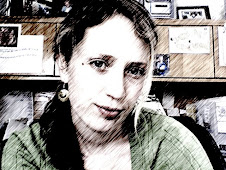
For this class, I was assigned to be a sort of
technology detective at Dimond, sniffing out technology in the school wherever I could find it. I first interviewed our Principal,
Cheryl Guyett, to find out whom I should talk to about technology at Dimond. She sent me over to
Charles McCubrey, who is Dimond’s Technology Coordinator. After interviewing Mr. McCubrey, I then questioned my mentor teacher,
Les Matz.
All three people that I interviewed seemed
pleased that someone was taking an interest in technology at Dimond. Mrs. Guyett and Mr. McCubrey helped to answer my technical questions, and I learned more about Dimond’s history with technology and current strengths and weaknesses from Mr. Matz.
I often start conversations about
technology in the field of
art with Mr. Matz. It seems he appreciates new technology, but doesn’t want to be a slave to it. Art is one of the few classes where you actually
craft things with your
hands. A printing press was considered technology at one time, a tube of paint, a kiln, a potter’s wheel. Now we have
Photoshop, but that doesn’t mean we should dismiss the value of creating things manually.
Technology-wise, Mr. Matz is facing the problem that many art teachers of a certain generation are, the change from
slide to
digital format. He has many slide shows made, but says that he cannot find new slide projectors anywhere for sale that fit his slide size. Mr. Matz’s projector is on its last legs, so he must go through the tedious task of scanning his slides one by one and forming digital shows from his laptop. He does have access to an
ELMO which is nice for some demonstrations, but something like a
SmartBoard where you can
save your work would be very useful his room.
In general, Dimond
prides itself on its technology, but it falls short from my perspective. The technology it does have is
concentrated in one area of the school, and there is a
lack of opportunity for
student involvement.
Full Report on Dimond’s Technology Culture







